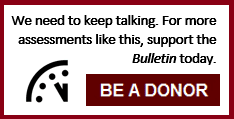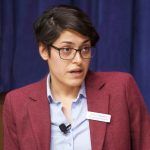Does it matter if Iran developed nuclear weapons at Parchin?
By Ariane Tabatabai | October 13, 2014

Last week, an explosion at the Iranian military complex known as Parchin drew even more attention to the site, already one of the most contentious in the country’s nuclear dossier. Since satellite imagery of the October 5 blast surfaced on the Internet, it has been pored over by non-proliferation experts and provoked ill-informed analysis by Iran hawks. Adding to the sense of urgency, the event occurred as Tehran and its six international negotiating partners strive to meet the November 24 deadline to reach a deal that would scale back the Iranian nuclear program and lift some sanctions, and just two days ahead of scheduled technical meetings between Iran and the IAEA that are part of the process.
With this key piece of the Iranian nuclear puzzle back in the spotlight, it’s worth reviewing just what we know about it, and what this tells us about the way forward for negotiations.
Parchin is a military complex just southeast of Tehran. It is under the control of the Defense Industries Organizations, which develop and make military equipment and weapons, and it houses a number of above- and underground facilities that research, produce, and store ammunition, explosives, rockets, and drones. The complex became topical in 2004, when the West accused Iran of having conducted nuclear weapon development-related activities there. In particular, experts expressed suspicions of research and development on “high explosive components for an implosion-type nuclear weapon.”
Since then, Parchin has been at the heart of discussions about the possible military dimensions of the Iranian nuclear program. This issue has divided analysts into two camps: those who believe that Iran’s history of weaponization is not relevant to the implementation of a potential deal, and that making it an issue could potentially have negative side-effects, and those who believe that unless Tehran comes clean and confesses to all its sins, there is no way forward.
Inspection visits would be required to verify whether any weapons development took place, and on that subject, too, there are different camps. Some, including former IAEA Deputy Director-General of Safeguards Olli Heinonen, have questioned the utility of such visits, as Iran could very well sanitize the building ahead of time, and even if it didn’t, and the agency didn’t find anything, critics would still accuse Tehran of having done so. (In 2012, reports that Iran was cleaning up Parchin surfaced but were contested.) Others, including former UN weapons inspector in Iraq Hans Blix, have defended the Iranian stance on Parchin, pointing out that no country would allow international inspectors into its military sites. IAEA Director General Yukiya Amano, however, maintains that access to Parchin is key to the agency’s ability to assess whether Iran’s nuclear program is peaceful in nature.
Starting 2004, the IAEA began to request that Iran let inspectors into Parchin to verify whether allegations of a link between the complex and the country’s suspected undeclared nuclear activities were valid. Tehran accepted in 2005, and the agency’s inspectors were able to visit one military site at Parchin and take several environmental samples. According to Iran (link in Persian), this was a confidence-building measure, a sign of its good faith despite not being obliged to cooperate. The IAEA “did not observe any unusual activities in the buildings visited, and the results of the analysis of environmental samples did not indicate the presence of nuclear material at those locations,” according to the agency’s report. Since that visit, the agency has asked to go back to Parchin a number of times, as it had not been able to visit the building where the alleged tests occurred. Iran has turned it down.
Parchin has come up a number of times as Tehran and the P5+1 (China, France, Germany, the United Kingdom, the United States, and Russia) have tried to reach a comprehensive deal to scale back Iran’s nuclear program for sanctions relief. But the Iranian government has made it very clear that another visit is not an option.
Now, as Iran and the P5+1 prepare to meet again in Vienna, with bilateral and multilateral meetings scheduled before the end of the week, most observers are turning their attention toward the issue of Parchin again.
The recent explosion reportedly (link in Persian) killed two people and was so loud that people came down to the streets, frightened. (The military complex is near a number of residential complexes and villages, including the Parchin residential complex less than a mile away, and the villages of Hesaramir, Hamamak, and Changi two to three miles away.) The Defense Industries Organizations issued a statement according to which there had been a fire in an explosives production workshop east of Tehran. Saham News–the website linked to Mehdi Karroubi, one of the leaders of the reformist-leaning Green Movement and a presidential candidate in the 2009 contested elections–broke the news that the incident had in fact occurred at Parchin (link in Persian). The Saham News account goes on to say that “the Parchin site is one of the military sites in Iran where solid propellants for ballistic missiles are produced without any safety principles or attention.”
Since then, Iranian officials have been quick to try to delink the incident from the nuclear debate. They have also downplayed the scale and nature of the event. The spokesman for the Iranian parliament’s National Security and Foreign Policy Commission stated (link in Persian) that “the fire at Parchin is not linked to the nuclear issue,” emphasizing that “this was a natural accident.” It went on: “This kind of accident normally occurs in chemical plants, and this incident was also in the chemical section of Parchin, which is a completely natural incident, possible in any plant that does chemical-related work,” including “non-military ones.” The spokesman, Hossein Naghavi-Hosseini, went on to complain that foreign news outlets “always try to relate whatever happens in our country to nuclear matters to show that the Islamic Republic of Iran is also engaging in nuclear activities, while this is absolutely not the case.” The Ministry of Foreign Affairs spokesperson, Marzieh Afkham, echoed these views (link in Persian). She also suggested that such events are a natural occurrence in these fields and that the incident is being blown out of proportion. She further noted that the Ministry of Defense had provided relevant information “on time and clearly.”
As Iran and the P5+1 get ready to enter the second to last round of negotiations ahead of the 24 November deadline, the possible military dimensions of Iran’s nuclear program continue to divide experts and politicians alike. One group views the issue as central to any progress, while the other believes other matters take priority. The questions surrounding the explosion at Parchin, as well as the opacity of the Iranian media on the matter, add more to the mystery and are likely to feed into these discussions. Iran hawks will probably jump on this occasion to push for more pressure on Tehran, while the country’s leadership is likely to remain silent on the events at Parchin due to the highly sensitive nature of the complex and its place in the country’s military.
Insisting that Tehran open up Parchin to the IAEA again—and come clean on any weapons development there—would only ensure that a nuclear deal does not materialize. It would add constraints on both sides. Iran has spent more than a decade telling the world, by way of a fatwa issued by its Supreme Leader, that it doesn’t and can’t seek nuclear weapons. Islam, it argues, prohibits these weapons. Asking Iran to come out and admit that it has sought nuclear weapons would be asking it to admit to having lied, not only to the international community, but also to the Iranian people for more than a decade. This would be embarrassing on the international stage, and delegitimizing domestically. And even if Tehran complied, it would be unlikely to address all the concerns about a possible military dimension in a satisfactory way.
Either the talks should just forego the issue, as some have suggested, or negotiators should seek creative solutions. Such solutions could in theory satisfy the West while offering Iran a face-saving way out. One idea offered in non-proliferation circles has been for Iran to provide a factually correct account of its possible military-related activities at Parchin, without actually declaring that developing nuclear weapons was the end goal. Instead it would give other explanations, such as that it was creating a nanodiamond. But trying to come clean on a lie by offering some truth wrapped in yet another lie is not likely to satisfy anyone. If anything, it would likely be counterproductive. While creative ideas are certainly worth exploring, they should be left for after a deal is reached and pursued outside the framework of the Iran talks as we approach the deadline. Because even if Tehran comes completely clean, Iran hawks won’t be satisfied and will push to exercise more pressure. In fact, they will see this as more ammunition to attack the negotiating parties and derail the talks.
Together, we make the world safer.
The Bulletin elevates expert voices above the noise. But as an independent nonprofit organization, our operations depend on the support of readers like you. Help us continue to deliver quality journalism that holds leaders accountable. Your support of our work at any level is important. In return, we promise our coverage will be understandable, influential, vigilant, solution-oriented, and fair-minded. Together we can make a difference.















